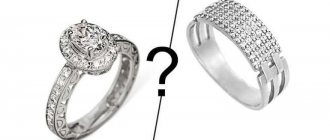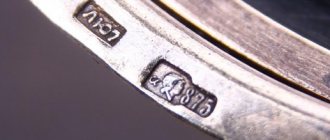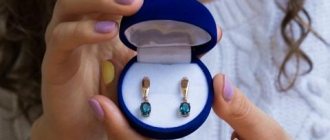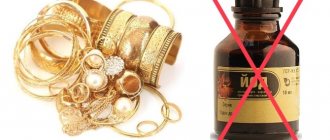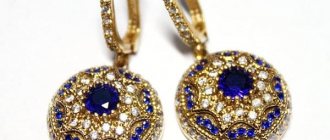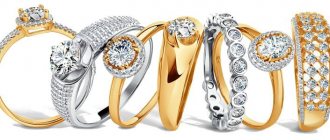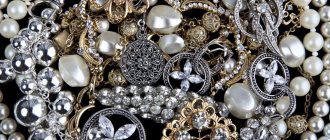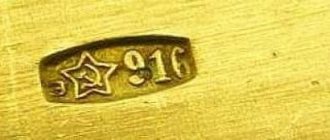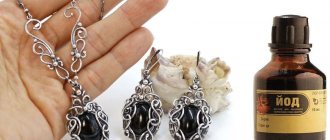Why is polishing white gold bad?
While rhodium plating makes the piece look shiny and white, it is not a great candidate for polishing precisely because of this finish.
Every time you take your jewelry to a professional, your piece is polished using an abrasive material that removes a tiny layer from the surface of the jewelry.
This is usually done using a machine that has a rotating sanding disc. The process of smoothing your ring removes a microscopic layer of metal from the ring until the surface is smoother.
And as you might have guessed, each time your jewelry is polished, the process removes some of the rhodium plating, little by little.
If the top layer of your jewelry has already worn away after long wear, polishing can remove whatever layer of metallization is still there, revealing the yellowish alloy underneath.
Even if the piece is not very worn, it may have deep scratches that require heavier polishing to remove, removing much of the rhodium.
Ring or earrings with one large stone
Dirt collects under the stone itself, which is difficult to remove. If you decide to clean and polish such a product at home, we recommend soaking it in a soapy solution for an hour. For these purposes, you can use liquid soap, cream dishwashing gel or shampoo. For shine after cleaning, add ammonia to this mixture and leave the gold in it for at least an hour. The water should be warm, almost hot.
Once you take the product out, you can quickly remove the dirt with a rag. But the residues that have collected on the stone from below can be removed with a toothpick.
Attention!
If you do not want to lose the stone, then you should remove dirt very carefully, without trying to pry off the stone itself.
What to do if your product is scratched?
But if white gold isn't the best candidate for polishing, what should you do if it does get scratched?
First of all, you should not polish your jewelry too often. Instead, wait until there are a lot of scratches and then take them to a jeweler for polishing.
At the same time, you can use a polishing cloth to keep your white gold shiny.
Polishing gold jewelry at home.
You can polish your gold rings and other jewelry at home using a special polishing cloth, which is available in most stores.
Please note that this method will only buff out very light scratches - if your jewelry is deeply scratched, it is best to have it professionally polished.
Make sure your jewelry is clean before using the polishing kit. You can wipe the products with a damp cloth soaked in soapy water.
Once you have cleaned and dried your piece, you can rub it with a cloth until it shines. If your gold jewelry contains gemstones, do not rub them as you may damage them.
This is not exactly a professional polish, but polishing your piece with a special polishing cloth will restore some of the original shine to your jewelry.
Professional polishing.
If your gold jewelry has a lot of scratches, some of which are deep, then it is best to take it to a professional.
Jewelers use polishing materials that are more abrasive than a regular polishing cloth, so professional polishing is more effective.
One of the inevitable downsides to polishing gold jewelry is that the process involves removing a tiny layer from the surface. This is why too many polishing sessions can wear out your gold jewelry.
How often should jewelry be polished?
Due to the abrasive nature of polishing, you don't need to go to the jeweler every time you notice a few visible scratches.
In general, polishing your jewelry more than once or twice a year will cause the rhodium plating to fade faster. In most cases, polishing your jewelry a couple of times a year is sufficient.
If you wear your jewelry very often, it will scratch faster and you may want to polish it more often. However, in this case, be prepared to pay more money to restore the color when the coating wears off.
As for polishing items with fabric, you can do it more often since these fabrics are not as abrasive, once a month or once every two to three months is an acceptable frequency.
How to get rid of scratches on a wedding ring?
How to get rid of scratches on a wedding ring?
- The only way to get rid of scratches on a wedding ring is to take it to a jewelry workshop and have it lightly polished. It is impossible to polish a ring to remove scratches using home methods.
- I clean my wedding ring, which is made of gold, with toothpaste and a piece of felt.
I apply a little toothpaste to it, let it sit for a few minutes and wipe it thoroughly with felt.
Then I rinse in water and wipe dry.
The ring becomes shiny and acquires a marketable appearance.
The gold decreases by the same amount as in the workshop, and maybe less :) But the scratches on the gold ring disappear.
- To remove scratches on a wedding ring, you need to use ammonia, which must be mixed with hydrogen peroxide, water and liquid soap. Everything needs to be mixed in equal proportions. All scratches on gold will disappear.
- Any gold product (without stones), just like silver, can be cleaned on river sand. At the very edge of the water, where the sand is the hardest. Just rub the jewelry on the sand (make sure there are no stones, otherwise you will scratch the metal). All scratches disappear instantly, and the product looks like new. I've done this a hundred times - the effect is wonderful.
- The easiest option is to take your ring to a jewelry workshop to polish. If you want, they will do ultrasonic cleaning for you. Get your ring back like new, shiny as soon as it comes from the store. For us, such a procedure costs a little more than 200 rubles, this includes cleaning, and polishing together.
info-4all.ru
How to restore color?
So, when the bottom layer of a piece of jewelry is exposed and it looks yellowish, what can you do to return it to white?
Actually, yes - you can always rhodium plate it again.
Almost every jeweler provides this service for a fee.
However, keep in mind that this may cost you $20-$50 or more.
Before you decide where to replate your jewelry, ask the jeweler about the method used and how thick the plating will be.
Why can polishing be harmful to your rings and other jewelry?
The biggest problem with polishing is that it primarily works by abrading the surface of the jewelry.
It is true that the amount of metal removed in the process is negligible and one polishing session cannot cause significant damage to it. However, after your jewelry has been polished repeatedly, the effect accumulates and the structure of your jewelry becomes weaker.
When it comes to rings, the most affected area when polishing is the frame, as it consists of small parts that are often very thin.
For example, if you have a serrated stone setting, the teeth themselves become thinner and shorter after each polishing of the ring.
This will also happen to other parts of the frame, and over time the frame will become increasingly weaker.
Once the frame of your ring loosens, the gemstones it holds will become loose. After some time, there is a high risk that they will fall out of the frame.
Jewelry should be polished no more than a few times a year. If you do this more often, you will soon begin to notice the negative effects of polishing.
Why does gold lose its shine?
First, let's understand the causes of jewelry contamination. There are three main reasons:
Gold just gets dirty
You wash your hands daily, but you don't wash your rings. You bathe, but do not wash the chain and pendant. You wash your hair, but don't wash your earrings. This causes a soapy coating to form on jewelry, and especially on stones, to which dust sticks. Later, this all turns into a layer of dirt on the back of the stones, which leads to the loss of their original shine.
Gold may darken
Gold and silver can darken when in contact with different chemical elements. Some of them are found in cosmetics, shampoos, shower gels and perfumes. Many girls use hand cream without removing their rings. They bathe in their jewelry and apply perfume on their jewelry. In addition, your jewelry (especially silver) may become very dark after swimming in a local body of water.
Gold gets scratched
Gold is a soft metal (silver is even softer). When you buy it, it shines because it is polished during manufacturing. When worn, jewelry gets scratched by almost everything it comes into contact with. Over time, they become covered with small scratches, causing the metal to become dull and lose its shine.
These are the main reasons for changes in the appearance and contamination of jewelry. Now let's see what we can do about it without leaving home.
How to avoid scratches?
You should get used to the fact that your jewelry will always have a few scratches, especially if it is made of a softer metal such as gold or silver.
It goes without saying that you need to protect your gold jewelry from shocks and collisions to avoid scratches.
If you want your ring to last longer, choose a piece made from a more durable metal such as platinum.
Platinum also scratches, but much more slowly than gold, and even when it does, it does not lose as much material, so polishing scratches in platinum jewelry is not as harmful to it.
Caring for gold. Simple and useful recommendations
It is not enough to purchase jewelry, you also need to be able to skillfully use it and store it competently.
At least eight highly qualified specialists work to ensure that the RingStudio decoration is not only ready on time, but also exceeds all your expectations. Your jewelry is made of precious metal, and all precious metals, as you know, have one thing in common - they are quite soft. And now the appearance of your jewelry will entirely depend on how carefully you wear it. We have prepared for you a list of simple rules, following which you will prolong the original appearance of your jewelry.
Please note that due to daily use and frequent contact with hard objects, rings will scratch and tarnish much faster than other jewelry. This is especially noticeable on rings with a flat surface (without a pattern).
— Remove jewelry before going to the gym or doing any mechanical work.
The surface of precious metals is much softer than most household items, and jewelry is the first to lose in this battle. It’s easy for a chain or earrings to get caught during intense work and not only deform them, but even cause discomfort and pain. Precious stones can also be damaged. Although they are naturally hard, once cut, stones become more susceptible to impacts and falls, and may become scratched or even chipped.
— Avoid contact of jewelry with chemicals
(when cleaning, washing dishes), as well as with cosmetics. Some substances found in cleaning and cosmetic products (such as mercury, chlorine, iodine) can leave stubborn stains on jewelry. But the most unpleasant thing is that their particles can settle on the jewelry and subsequently cause a serious allergy.
— If dirt gets into the jewelry design, dip it in a warm soapy solution (a few drops of dishwashing detergent or shampoo in a glass of water), wash difficult areas with a soft brush, rinse under running clean water and dry with a soft flannel cloth. If the stains are heavy, leave the jewelry in the solution all day and shake it periodically. This recipe is perfect for rings with stones - they return their former shine and beauty.
— You should not wear jewelry to the beach.
Sand easily scratches the surface (regardless of whether it is polished or matte). Also, when swimming, the ring may slip off a finger that has become narrowed by cold water.
— White gold jewelry is almost always plated with rhodium to give it more shine and whiteness. But, contrary to popular belief, rhodium plating cannot protect the product from external mechanical influences. And the appearance of scratches on white gold products, as well as on any other jewelry made of precious metals, is, alas, inevitable. Like any coating, rhodium wears off over time and the jewelry begins to take on a yellowish tint. To avoid this, we recommend that you update your rhodium plating as needed.
But even if it happens that your jewelry is frayed, scratched and does not look the same as before, do not be upset. You can always bring them to our jewelry service, where experienced jewelers will return them to their original appearance.
A distinctive feature of our service is that we always try to ensure that the repair of a product is carried out by the jeweler who made it.

